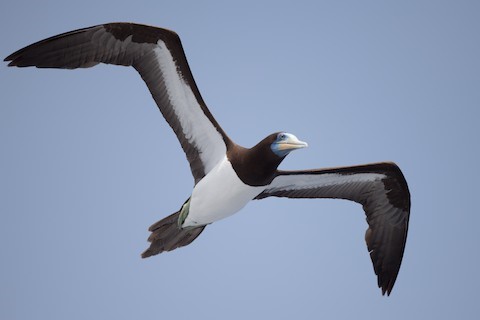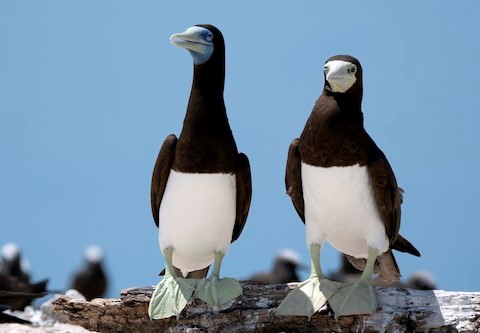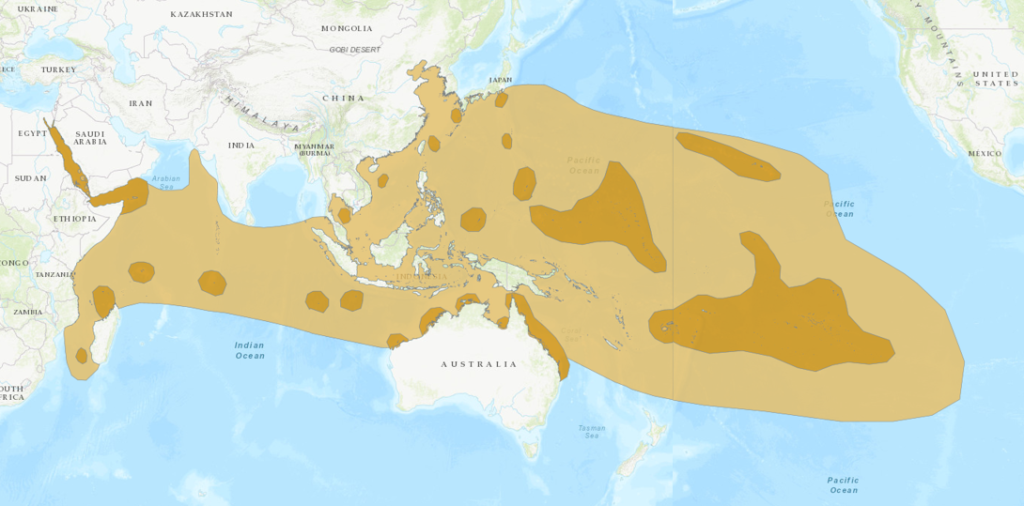Birdfinding.info ⇒ The Indo-Pacific form of Brown Booby is locally common in several parts of its large range, including coastal waters of the Red Sea, northern Taiwan, southwestern Japan (Kyushu), Queensland, Hawaii, and French Polynesia. Some relatively accessible breeding sites include: Michaelmas Cay (Queensland), Moku Manu (near Makapu’u Point, Oahu), and Pauwalu Point (near Ke’anae, Maui).
“Forster’s Booby”
Sula leucogaster plotus
Tropical Indian and Pacific Oceans. Occurs in both coastal and offshore waters.
Breeding. Nests mainly on rocky islets and sea cliffs.
In the Indian Ocean region, breeds on many islets in the Red Sea, a few in the Timor Sea (Ashmore Reef, Adele, and the Lacapede Islands), and very locally in between, including islets around Socotra; the Chagas Archipelago, the Cocos Keeling Islands, and Christmas Island.
In the North Pacific, on many of Japan’s southern and offshore islands (Ryukyu, Ogasawara, Iwo); islets north of Taiwan; the Philippines (Tubbataha Reefs in the Sulu Sea); Palau (Fanna Island); and on most islands groups of Micronesia east to Hawaii (from Kure to Maui).
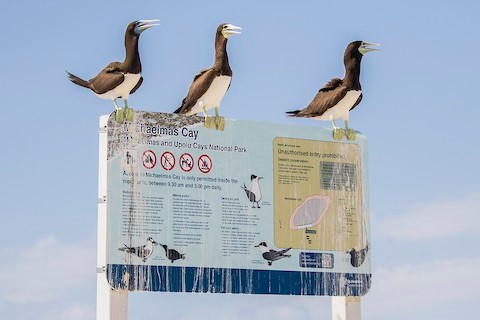
“Forster’s Booby”, S. l. plotus, male and two females, on the Michaelmas Cay welcoming committee. (Michaelmas Cay, Queensland, Australia; January 17, 2020.) © Matthew Kwan
In the South Pacific, on islets of Northern Australia (in the Gulf of Carpenaria), Queensland, the Bismarck Archipelago, the Solomon Islands, New Caledonia, and east across Melanesia and Polynesia to the Marquesas. May also breed in small numbers or sporadically farther east to the Gambier Islands.
The Hawaiian population is estimated at approximately 1,500 pairs, with the largest colonies on Lehua (~500 pairs) and Ka’ula (~400), and smaller colonies on Nihoa (~175), Moku Manu (~100), Kure (~55), Pearl and Hermes Reefs (~55), French Frigate Shoals (~50), Laysan (~35), Necker (~25), Lisianski (~20), Gardener Pinnacles (~10), and Pauwalu Point, Maui (~10).
Nonbreeding. Largely resident around its breeding grounds, and small numbers also disperse during most of the year across large portions of the Indian and Pacific Oceans.
Identification
Similar to the other forms of Brown Booby: dark brown overall, with a crisply defined bright white belly and underwing linings, and pale bill and feet. Females of the three forms are nearly identical, with only subtle differences in bare parts coloration and underwing pattern, while the males are much more distinctive.
Male “Forster’s” typically has blue facial skin and a horn-colored or straw-yellow bill, often with a slight bluish tint, and pale greenish-yellow feet.
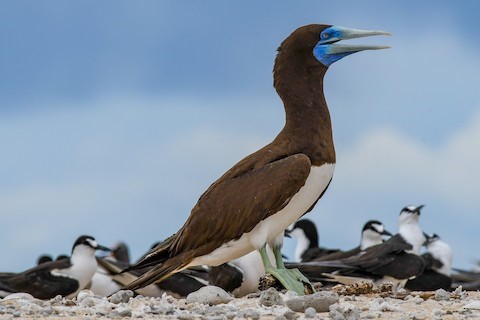
“Forster’s Booby”, S. l. plotus, male showing maximally blue facial skin. (Michaelmas Cay, Queensland, Australia; January 5, 2017.) © Terence Alexander
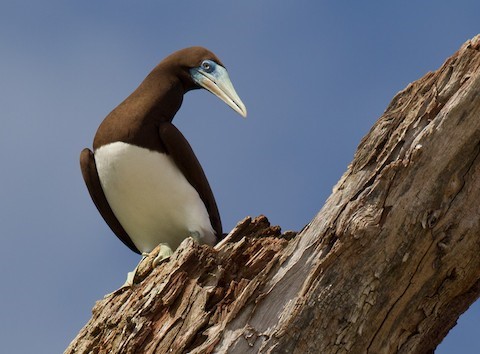
“Forster’s Booby”, S. l. plotus, male showing subtly bluish facial skin. (Tench Island, New Ireland, Papua New Guinea; July 13, 2014.) © Lars Petersson
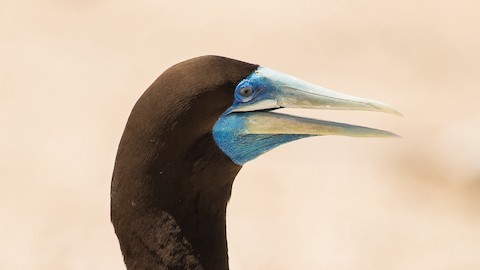
“Forster’s Booby”, S. l. plotus, male showing vivid blue facial skin. (Michaelmas Cay, Queensland, Australia; October 15, 2019.) © Xiwen Chen
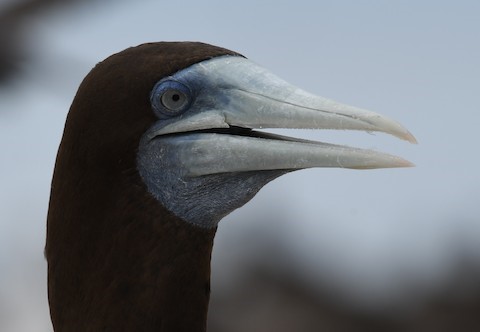
“Forster’s Booby”, S. l. plotus, male showing dull blue facial skin. (Michaelmas Cay, Queensland, Australia; January 5, 2017.) © Terence Alexander
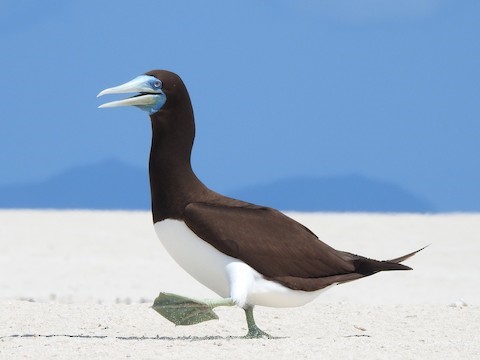
“Forster’s Booby”, S. l. plotus, male showing typically blue facial skin. (Michaelmas Cay, Queensland, Australia; September 25, 2020.) © Scott Fox
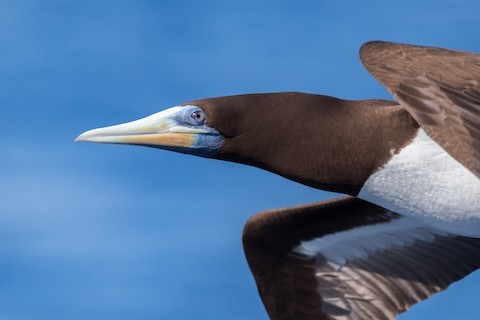
“Forster’s Booby”, S. l. plotus, male showing blue facial skin. (Offshore from the Ogasawara Islands, Japan; September 20, 2020.) © Yann Muzika

“Forster’s Booby”, S. l. plotus, male, showing typically blue facial skin. (Michaelmas Cay, Great Barrier Reef, Queensland, Australia; December 2, 2017.) © Ian Davies
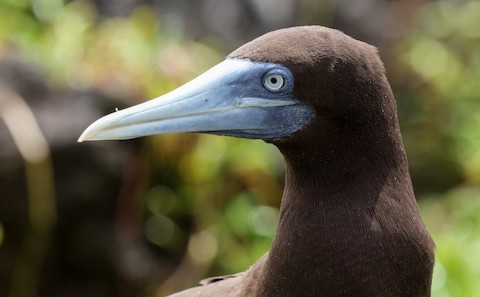
“Forster’s Booby”, S. l. plotus, male showing dull blue facial skin. (Christmas Island; July 29, 2017.) © Hickson Fergusson
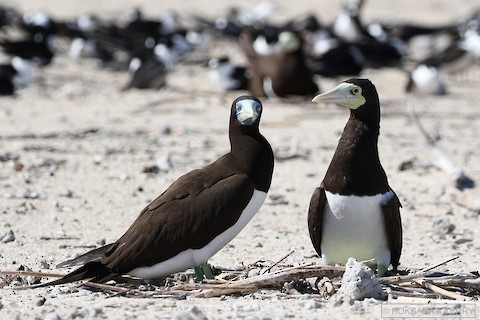
“Forster’s Booby”, S. l. plotus, male and female. (Michaelmas Cay, Queensland, Australia; August 12, 2018.) © Roksana and Terry
Female “Forster’s” typically has a pale, slightly pinkish bill, pale greenish-yellow facial skin with a dark spot in front of the eye, and pale greenish-yellow feet.
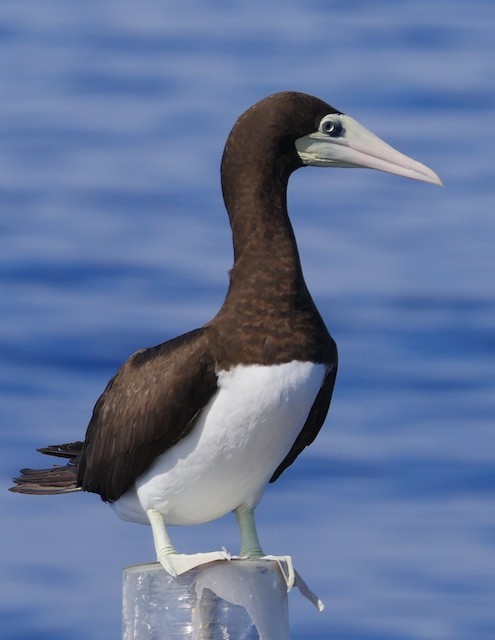
“Forster’s Booby”, S. l. plotus, female, showing pinkish bill, and pale greenish-yellow facial skin and feet. (Offshore from Kahalu’u-Keauhou, Hawaii; September 15, 2017.) © Roger L. Horn
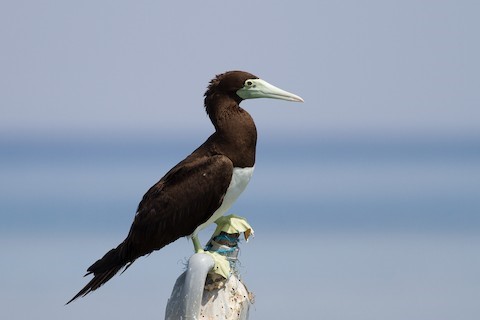
“Forster’s Booby”, S. l. plotus, female. (Hamata Islands, Egypt; July 28, 2013.) © Raphael Lebrun

“Forster’s Booby”, S. l. plotus, female on nest. (Michaelmas Cay, Queensland, Australia; October 12, 2019.) © Nik Mulconray

“Forster’s Booby”, S. l. plotus, female, showing pinkish bill, pale greenish-yellow facial skin and feet. (Offshore from from Kailua-Kona, Hawaii; September 25, 2016.) © Brian Sullivan
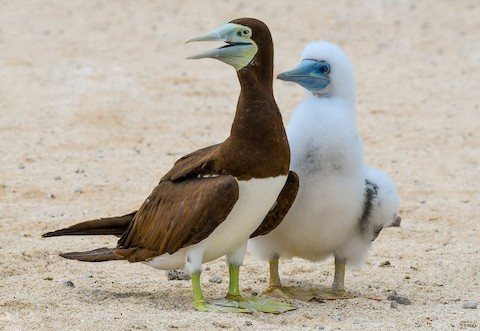
“Forster’s Booby”, S. l. plotus, female with chick. (Michaelmas Cay, Queensland, Australia; January 5, 2017.) © Terence Alexander
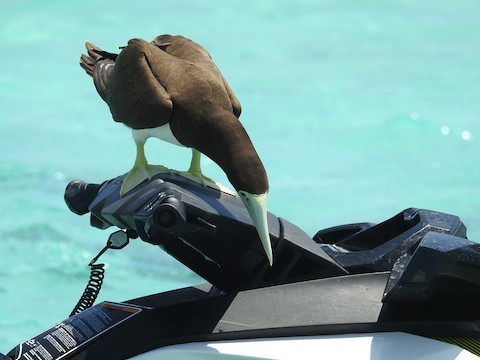
“Forster’s Booby”, S. l. plotus, female, exhibiting curiosity. (Offshore from Moorea, French Polynesia; March 12, 2018.) © Debbi Senechal
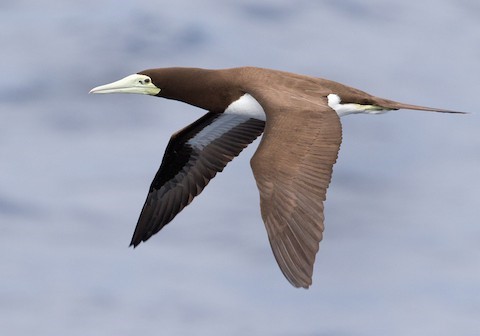
“Forster’s Booby”, S. l. plotus, female. (Offshore between Torishima and the Ogasawara Islands, Japan; May 27, 2017.) © Lars Petersson
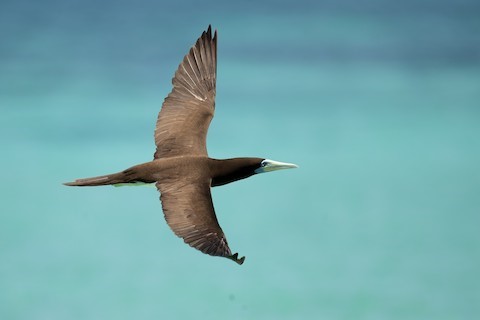
“Forster’s Booby”, S. l. plotus, male, dorsal view showing slightly darker brown hood. (Michaelmas Cay, Queensland, Australia; January 2, 2020.) © JJ Harrison
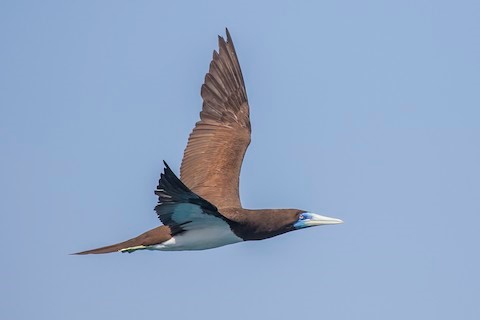
“Forster’s Booby”, S. l. plotus, male. (Michaelmas Cay, Queensland, Australia; January 17, 2020.) © Matthew Kwan
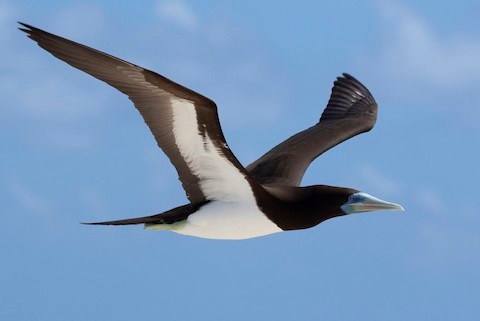
“Forster’s Booby”, S. l. plotus, male. (Michaelmas Cay, Queensland, Australia; November 15, 2018.) © Michael Todd

“Forster’s Booby”, S. l. plotus, female. (Offshore from the Ogasawara Islands, Japan; August 8, 2020.) © Yann Muzika
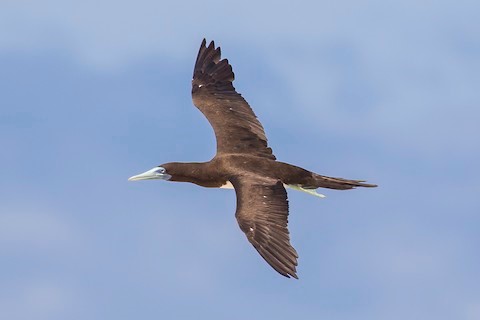
“Forster’s Booby”, S. l. plotus, male, dorsal view showing slightly darker brown hood. (Michaelmas Cay, Queensland, Australia; January 17, 2020.) © Matthew Kwan
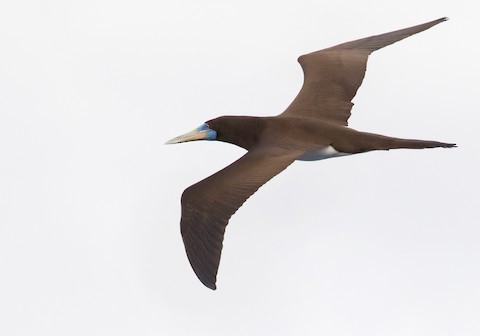
“Forster’s Booby”, S. l. plotus, male, dorsal view showing slightly darker brown hood. (Offshore between Torishima and the Ogasawara Islands, Japan; May 27, 2017.) © Lars Petersson
In flight, the underwing is mostly dark-brown with contrasting bright-white coverts that extend out to the wrist—usually more extensive white than on “Brewster’s”.
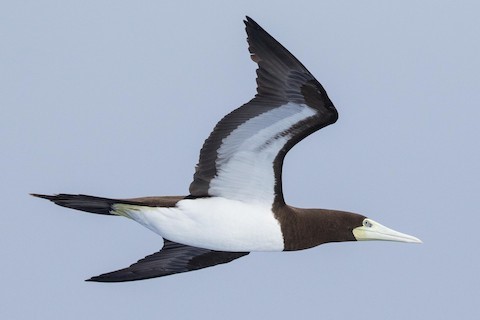
“Forster’s Booby”, S. l. plotus, female—note mostly white underwing coverts with dark “spurs” projecting into them. (Southeast of Necker Island, Hawaii; March 30, 2020.) © Eric VanderWerf
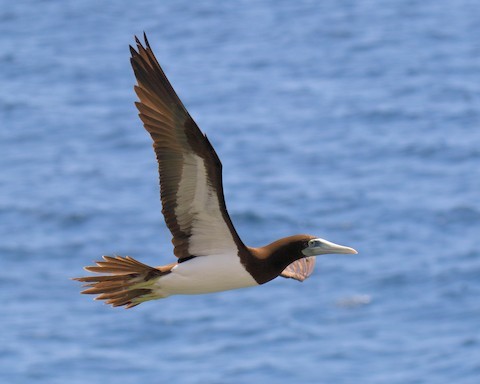
“Forster’s Booby”, S. l. plotus, female. (Christmas Island; August 14, 2015.) © Ian K. Barker
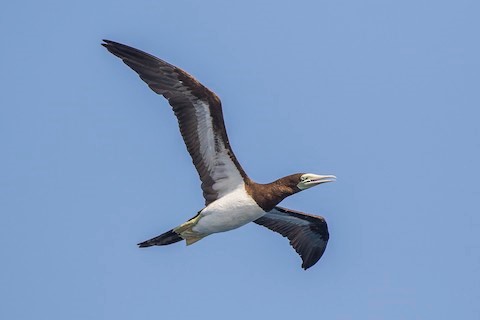
“Forster’s Booby”, S. l. plotus, female showing underwing coverts more than average dark feathers in the underwing coverts. (Michaelmas Cay, Queensland, Australia; January 17, 2020.) © Matthew Kwan
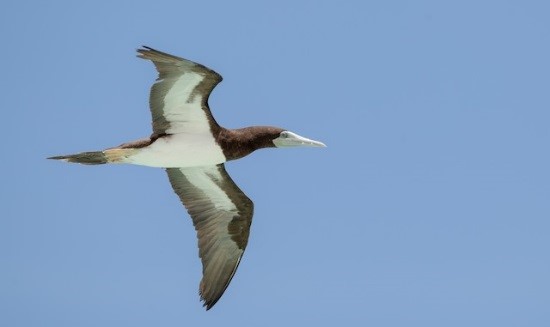
“Forster’s Booby”, S. l. plotus, female—note mostly white underwing coverts with dark “spurs” projecting into them. (Michaelmas Cay, Queensland, Australia; December 2, 2017.) © Ian Davies
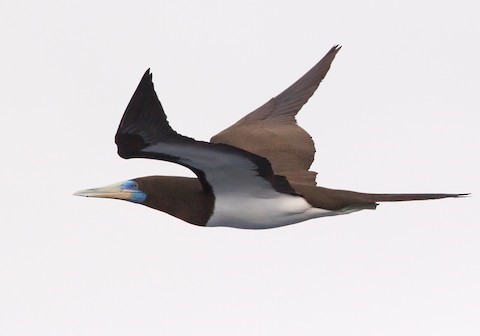
“Forster’s Booby”, S. l. plotus, male showing vivid blue facial skin and yellow bill. (Offshore between Torishima and the Ogasawara Islands, Japan; May 27, 2017.) © Lars Petersson
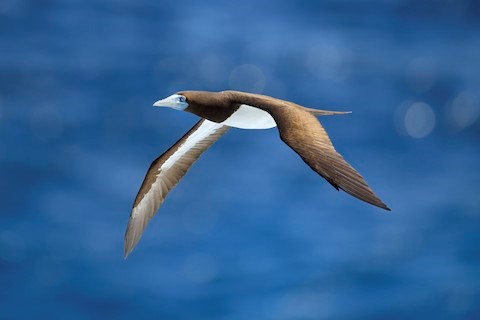
“Forster’s Booby”, S. l. plotus, male. (Cengeite, Mare, New Caledonia; March 11, 2018.) © Paul Maury
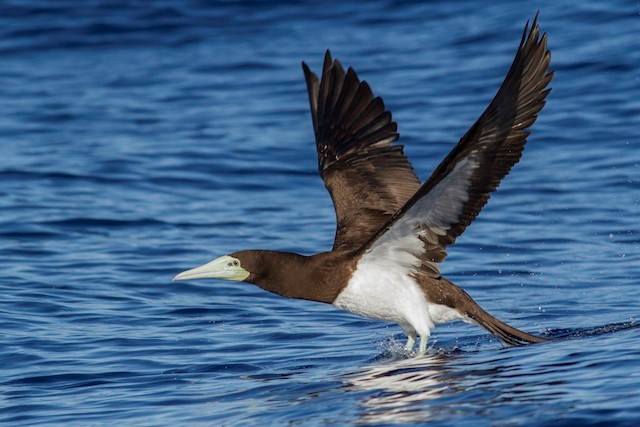
“Forster’s Booby”, S. l. plotus, female. (Kaulakahi Channel, Hawaii; June 12, 2016.) © Jacob Drucker

“Forster’s Booby”, S. l. plotus, male showing extensively white underwing coverts. (Tench Island, New Ireland, Papua New Guinea; July 13, 2014.) © Lars Petersson
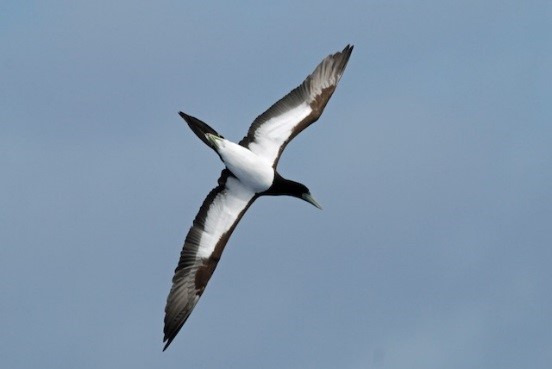
“Forster’s Booby”, S. l. plotus, male showing extensively white underwing coverts. (Northern Mariana Islands; April 12, 2009.) © Nigel Voaden
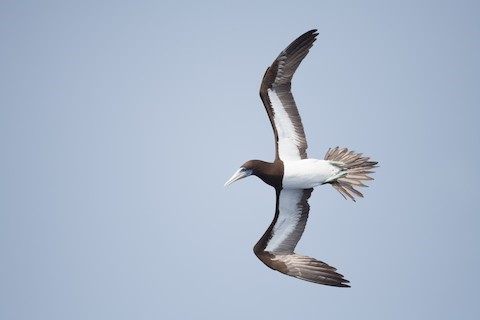
“Forster’s Booby”, S. l. plotus, male showing extensively white underwing coverts. (Offshore south of Chichijima, Ogasawara Islands, Japan; August 5, 2020.) © Yann Muzika
Immature Plumages. Before attaining full adult plumage, “Forster’s Boobies” go through a progression of changes in plumage and bare parts coloration.
Juveniles are almost entirely medium-to-dark brown with a dark-gray bill and facial skin.
As they age, the belly and underwing linings become progressively whiter, and the facial skin and bill lighten. A pronounced line of demarcation between the solid brown chest and paler (eventually white) belly is noticeable at all stages after juvenile.
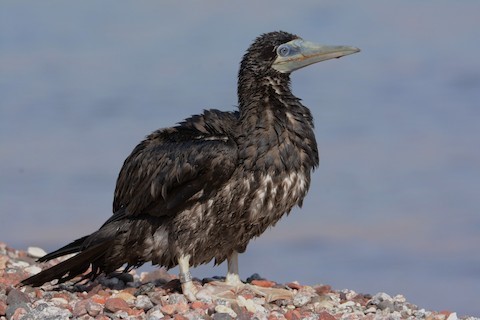
“Forster’s Booby”, S. l. plotus, immature (oiled?). (Eilat, Israel; March 28, 2017.) © Itamar Donitza
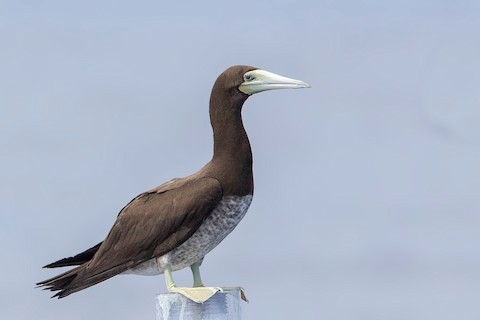
“Forster’s Booby”, S. l. plotus, subadult female. (Offshore from Kailua-Kona, Big Island, Hawaii; September 14, 2018.) © Bradley Hacker
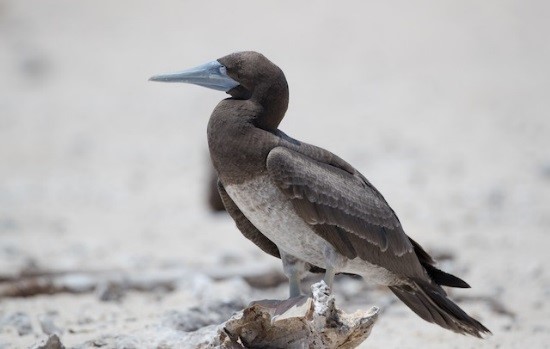
“Forster’s Booby”, S. l. plotus, immature. (Michaelmas Cay, Great Barrier Reef, Queensland, Australia; December 2, 2017.) © Ian Davies
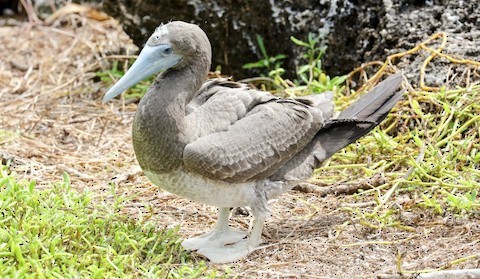
“Forster’s Booby”, S. l. plotus, immature, with brown coloration appearing bleached out—it is not clear whether this is due to the lighting or aberrant plumage. (Christmas Island; July 29, 2017.) © Hickson Fergusson
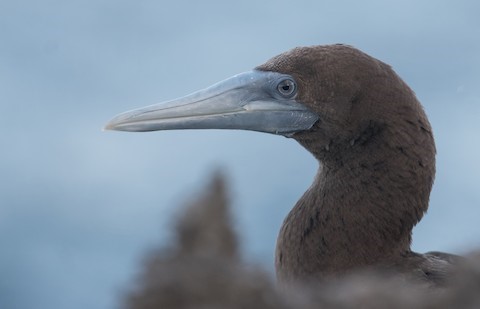
“Forster’s Booby”, S. l. plotus, immature. (Ma Chor Nui Nui Temple, Christmas Island; August 13, 2017.) © Bill Bacon
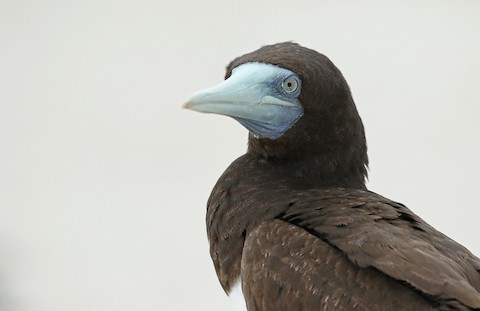
“Forster’s Booby”, S. l. plotus, subadult male. (Michaelmas Cay, Queensland, Australia; March 1, 2016.) © Luke Seitz
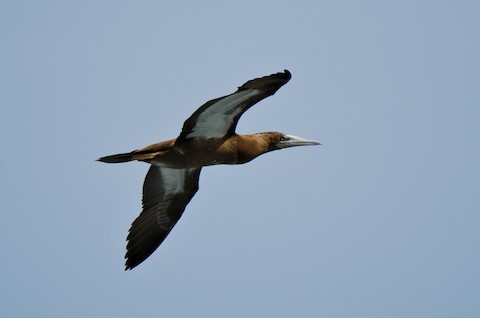
“Forster’s Booby”, S. l. plotus, immature female, showing extensively white underwing coverts. (Pauwalu Point, Maui, Hawaii; February 1, 2020.) © Zeke Smith

“Forster’s Booby”, S. l. plotus, immature. (Northeast Point, Christmas Island; November 10, 2016.) © Bill Bacon
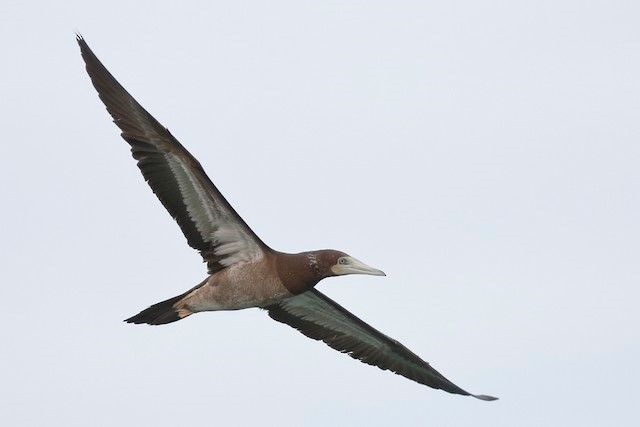
“Forster’s Booby”, S. l. plotus, immature female. (Kekaha Beach Park, Kauai, Hawaii; February 18, 2018.) © Sharif Uddin
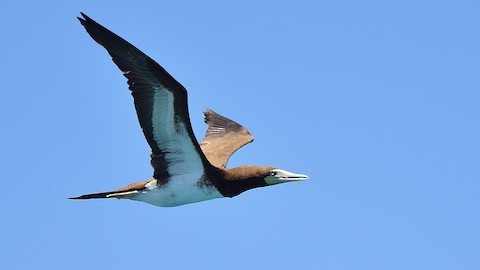
“Forster’s Booby”, S. l. plotus, subadult female. (Michaelmas Cay, Queensland, Australia; October 15, 2019.) © Xiwen Chen
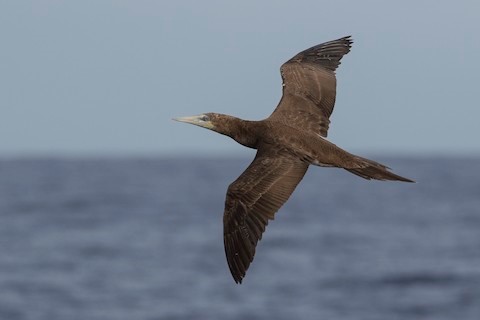
“Forster’s Booby”, S. l. plotus, subadult. (Offshore from Kailua-Kona, Big Island, Hawaii; March 24, 2019.) © Jacob Drucker
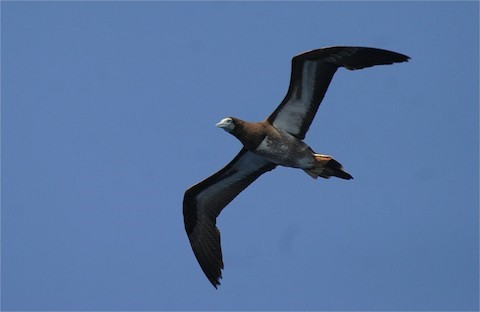
“Forster’s Booby”, S. l. plotus, immature. (Restorf Island, West New Britain, Papua New Guinea; April 6, 2007.) © Ken Havard
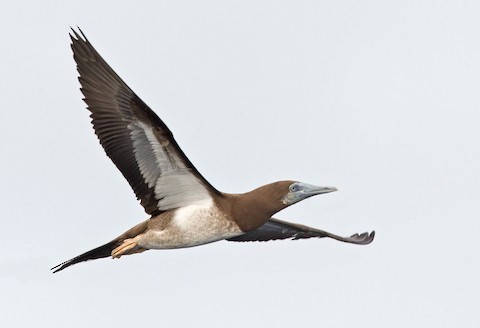
“Forster’s Booby”, S. l. plotus, immature. (Wilson Strait, Solomon Islands; July 12, 2015.) © Lars Petersson
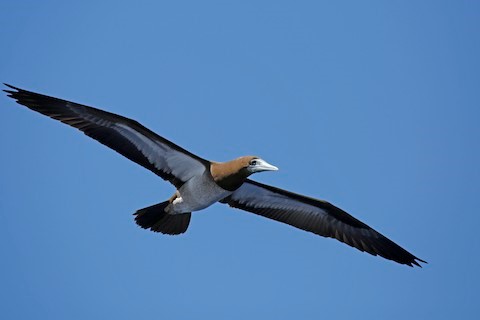
“Forster’s Booby”, S. l. plotus, subadult male. (South of Ni’ihau, Hawaii; October 14, 2019.) © Laura Keene
Cf. “Brewster’s Booby”. “Brewster’s” and “Forster’s” Boobies occur together regularly in the central Pacific, mainly in the Hawaiian and Line Islands, and overlap at least occasionally over a large portion of the Pacific Ocean from Japanese to Mexican waters and south into Polynesia.
Adult male “Brewster’s” is easily recognized by its pale head, but males of the other two forms and females of all three (especially “Brewster’s” and “Forster’s”) are extremely similar. Immatures appear to be indistinguishable until they begin to show a distinctive aspect of their adult coloration—such as the paler facial plumage of male “Brewster’s” or “Atlantic’s” yellower feet.
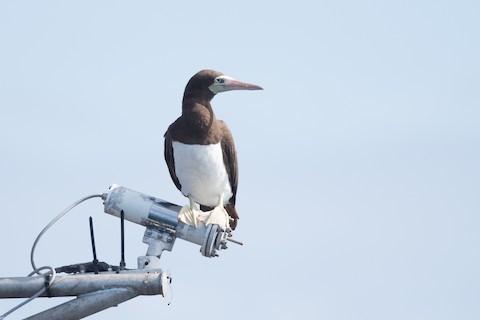
“Brewster’s Booby”, S. l. brewsteri, female, far west of its normal range—identified by thin, pinkish bill and dark portions of underwing coverts not shown here. (35 km offshore from Miyako, Iwate, Honshu, Japan; July 23, 2020.) © Yann Muzika

“Brewster’s Booby”, S. l. brewsteri, immature male, far west of its normal range—distinguished from the expected “Forster’s” by pale feathering on the face. (Offshore south of Nihoa Island, Hawaii; April 5, 2018.) © Eric VanderWerf
Adult male “Brewster’s” is easily recognized by its pale head, but females of both are extremely similar to one another and fairly similar to male “Forster’s”. Immatures appear to be indistinguishable until they begin to show a distinctive aspect of their adult coloration.
Even with clear, high-resolution images, female Brown Boobies are not always assignable to a particular form. To distinguish female “Brewster’s” and “Forster’s”, the key features are bill color, bill size, and underwing pattern:
Bill Color: Females of both forms can show a pinkish flush on the bill. “Brewster’s” is consistently pinkish, whereas “Forster’s” tends to appear more yellowish or ivory, but sometimes has a pinkish hue.
Bill Size: “Brewster’s” is slightly smaller than “Forster’s” and its bill averages somewhat thinner. This difference is probably too slight to be useful except at the extremes.
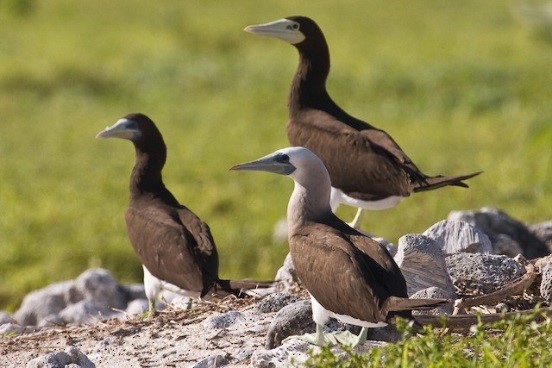
“Forster’s Booby”, S. l. plotus, male and female, with male “Brewster’s Booby”, S. l. brewsteri, male in foreground—note the size difference between the large female and both smaller males. (Wake Island; October 24, 2010.) © Eric VanderWerf

“Forster’s Booby”, S. l. plotus, immature female, showing extensively white underwing coverts, as is typical of this form. (Pauwalu Point, Maui, Hawaii; February 1, 2020.) © Zeke Smith
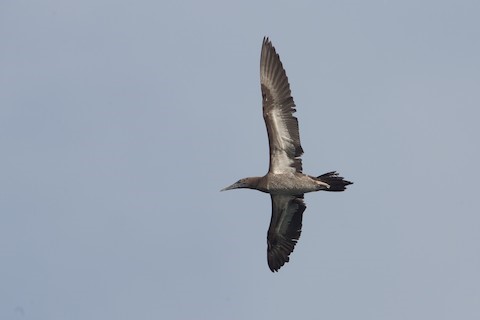
“Brewster’s Booby”, S. l. brewsteri, immature, showing limited whitish underwing coverts, as is typical of this form. (Isla Peña Blanca, Colima, Mexico; February 2, 2005.) © Simon Colenutt
Underwing Coverts: On average, “Brewster’s” has more limited white underwing coverts, with a thick brown bar near the wrist and often a dark spur or stripe that projects from the wrist area toward the body. In contrast, “Forster’s” usually has almost entirely white underwing coverts. However, both forms vary to some to extent, and younger birds tend to have more dark covert feathers. The underwing pattern is most useful when the coverts are all-white, because this effectively rules out “Brewster’s”.
Cf. “Atlantic Booby”. “Atlantic” and “Forster’s” Boobies are extremely similar but rarely if ever overlap. “Atlantic” is known only from the Atlantic Ocean and “Forster’s” is known only from the Indian and Pacific Oceans, but both are highly mobile and could occur nearly anywhere.
Male “Atlantic” and “Forster’s” have approximately the same plumage but are fairly easy to distinguish by the color of their facial skin: orange on “Atlantic” versus dark-blue on “Forster’s”. Their foot color also differs: orangish-yellow on “Atlantic” versus greenish-yellow on “Forster’s”.
Even with clear, high-resolution images, female Brown Boobies are not always assignable to a particular form. To distinguish female “Atlantic” and “Forster’s”, the key features are the coloration of the bill, facial skin, and feet:
Bill Color: Female “Atlantic” has a consistently pinkish bill, whereas “Forster’s” tends to appear more yellowish or ivory, but sometimes has a pinkish hue.
Facial Skin and Foot Color: Female “Atlantic” has pure yellow facial skin and feet, whereas “Forster’s” appears closer to white or greenish-yellow.
Immatures appear to be indistinguishable until they begin to show a distinctive aspect of their adult coloration—such as the paler facial plumage of male “Brewster’s” or “Atlantic’s” yellower feet.
Cf. Red-footed Booby. Dark morph Red-footed Boobies, which predominate in some populations—especially in the eastern Pacific—can be all-brown, and the juveniles in particular strongly resemble juvenile and immature Brown Boobies.
Typically, juvenile Brown Boobies are darker than these Red-footeds and more uniformly colored above and below. Immature Browns become distinctive as the belly lightens because the lightened area is sharply defined, matching the adult plumage.
Most juvenile Red-footed Boobies have a perceptibly darker breastband. As they age, dark morph Red-footed Boobies turn coffee-colored rather than dark brown.
Cf. Other Juvenile Boobies. Juvenile Masked, Nazca, and Blue-footed Boobies have roughly the same pattern as adult Brown Boobies, for which they are often mistaken. Under suboptimal viewing conditions they can be indistinguishable, but if seen clearly the crisp bicolored plumage of adult Brown Boobies is unique.
Notes
Monotypic form, one of three distinct forms of Brown Booby (S. leucogaster), sometimes regarded as separate species (e.g., Howell and Zufelt 2019).
References
Alderfer, J., and J.L. Dunn. 2014. National Geographic Complete Birds of North America (Second Edition). National Geographic Society, Washington, D.C.
BirdLife International. 2018. Sula leucogaster. The IUCN Red List of Threatened Species 2018: e.T22696698A132590197. https://dx.doi.org/10.2305/IUCN.UK.2018-2.RLTS.T22696698A132590197.en. (Accessed June 28, 2021.)
Brazil, M. 2009. Birds of East Asia. Princeton University Press.
eBird. 2021. eBird: An online database of bird distribution and abundance. Cornell Lab of Ornithology, Ithaca, N.Y. http://www.ebird.org. (Accessed June 28, 2021.)
Harrison, P. 1983. Seabirds: An Identification Guide. Houghton Mifflin, Boston.
Hollom, P.A.D., R.F. Porter, S. Christensen, and I. Willis. 1988. Birds of the Middle East and North Africa. T & AD Poyser, Calton, England.
Howell, S.N.G., and K. Zufelt. 2019. Oceanic Birds of the World. Princeton University Press.
McMullan, M., and T. Donegan. 2014, Field Guide to the Birds of Colombia (Second Edition). Fundación Proaves de Colombia, Bogotá.
Pratt, H.D., P.L. Bruner, and D.G. Berrett. 1987. A Field Guide to the Birds of Hawaii and the Tropical Pacific. Princeton University Press.
Pyle, R.L., and P. Pyle. 2017. The Birds of the Hawaiian Islands: Occurrence, History, Distribution, and Status. Version 2 (January 1, 2017). http://hbs.bishopmuseum.org/birds/rlp-monograph/. B.P. Bishop Museum, Honolulu, Hawaii.
Robson, C. 2002. Birds of Thailand. Princeton University Press.
Sinclair, I., P. Hockey, W. Tarboton, and P. Ryan. 2011. Birds of Southern Africa (Fourth Edition). Random House Struik (Pty) Ltd. Cape Town, South Africa.
Xeno-Canto. 2021. Brown Booby – Sula leucogaster. https://www.xeno-canto.org/species/Sula-leucogaster. (Accessed June 28, 2021.)
